Scottish winter oilseed rape cultivation 2015-2016: impact of the second year of neonicotinoid seed treatment restrictions
Survey on the impact of current EU neonicotinoid seed treatment restrictions on Scottish winter oilseed rape cultivation.
Results and comparison with previous survey
Survey sample
One hundred and four growers participated in this survey. The sample consisted of 50 participants from the original 2014/15 survey and 54 new recruits drawn from a sample of Scottish WOSR growers (13) . These growers collectively sowed 5,553 hectares (ha) of WOSR on 131 farms. This sample represents18 per cent of the 2016 Scottish crop area (6) . The areas sampled in each region reflect the geographic distribution of Scottish oilseed rape cultivation, accounting for between 13 and 22 per cent of the crop grown in the main WOSR producing regions ( Table 1).
The total area of WOSR sown in Scotland decreased by 14 per cent between 2014 and 2015 (35,198 and 30,141 ha, respectively) (6) . The 2015/16 crop area is 9 per cent lower than the ten year average of 33,263 ha (2007 to 2016) reported in the Scottish agricultural census (6) . There were also reductions in areas of winter cereals sown in 2015 and these declines in winter crops were in part attributed to the late harvest in 2015, followed by a period of very wet weather, which made planting autumn-sown crops problematical (14) . These difficulties were encountered by several farmers who were contacted in relation to the survey. Four potential participants, who had collectively intended to sow over 800 ha of WOSR in autumn 2015, stated that they were unable to do so due to the late harvest or wet weather at sowing.
The number of participants, and crop area, surveyed were similar to the previous survey in which 96 growers, collectively growing 5,465 ha, were surveyed, representing 14 per cent of the 2015 WOSR crop.
Drilling date and seed rate
All WOSR encountered in this survey was sown between August and September 2015. The majority of crops were sown in August (83 per cent of growers and 84 per cent of the crop area) with most of the crop drilled in the last two weeks of the month (81 per cent of growers and crop area) ( Table 2).
As discussed in the previous section it has been reported that the late 2015 harvest delayed, and in some cases prevented, sowing of winter crops in Scotland. This delay in sowing was reflected in our survey data for the two consecutive seasons (Figure 1).
The median seed rate was 2.5 kg/ha (range 1.4 to 5.0 kg/ha). Hybrid WOSR varieties were drilled at lower rates than conventional varieties. The median seed rate recorded in the previous survey was 3 kg/ha (range 1.2 to 6 kg/ha). This reduction in seed rate may have been influenced by fewer of the growers in this survey increasing their seed rate as mitigation for CSFB damage. In the previous survey 11 per cent of growers adapted seed spacing and rate in autumn 2014, compared to four per cent in autumn 2015 (refer to following operational changes section).
Figure 1 WOSR sowing period in 2014/15 and 2015/16 surveys
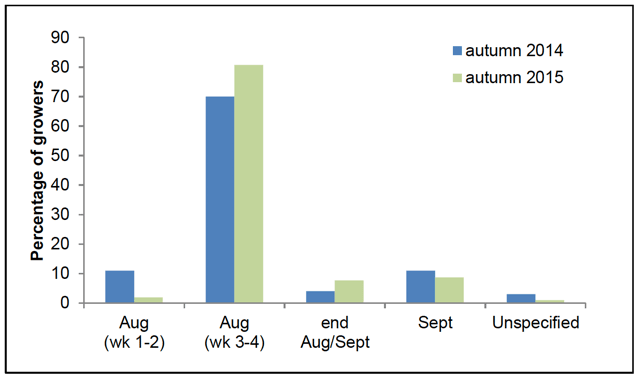
Operational changes in crop cultivation in response to restrictions
Growers were asked if they had made any changes to their crop cultivation practices to attempt to mitigate for the absence of insecticidal seed treatments.
A total of 16 growers, 15 per cent of the sample, reported they had made operational changes ( Table 3). These cultivation techniques were collectively applied to 847 ha, 15 per cent, of the crop surveyed. In all cases, the stated aim of this adaptation to practice was to reduce the impact of potential CSFB damage.
Six per cent of the growers surveyed, collectively growing 350 ha of crop (six per cent of the sample) adopted different soil cultivation techniques, such as minimum tillage, strip tillage and direct drilling. This change in cultivation was designed to allow the earliest possible establishment of the crop, with the aim of avoiding CSFB migration coinciding with crop emergence, when seedlings are most vulnerable to damage.
A further four per cent of farmers, growing 203 ha, adjusted drilling dates with a similar strategy of production of a well-established crop that could out-compete CSFB damage. Increasing seed rate, or amending row spacing, to mitigate for potential crop loss was implemented by four per cent of the surveyed growers on 221 ha of land. Two participants used fertilisers, in the form of a seed dressing and precision fertiliser delivery at drilling on 56 and 18 ha respectively. The aim of the fertiliser use was to encourage quicker establishment and greater crop vigour, to compensate for insect grazing.
These 16 growers were asked if they thought that the operational changes had helped with crop establishment and performance. The majority of growers (seven, collectively growing 297 ha) stated that they were unaware if their actions had made a difference to crop performance. These growers used a range of operational changes including using fertiliser at drilling and altering seed rate, spacing and cultivation methods. Five growers (collectively growing 370 ha) stated that the actions had improved crop performance. These growers amended drilling dates, soil cultivations and seed rate. Two growers (88 ha) stated that they had seen no improvement in the crop in response to amending soil cultivation techniques and using a fertilising seed treatment. The remaining two growers did not provide a response to this question.
In the previous survey, a greater proportion of the farmers surveyed made operational changes (Figure 2). Twenty five growers (26 per cent of the sample), collectively growing 2,032 ha and representing 37 per cent of the crop surveyed, made one or more cultural changes to their 2014 sown crop.
Figure 2 Operational changes in crop cultivation in 2014/15 and 2015/16 surveys
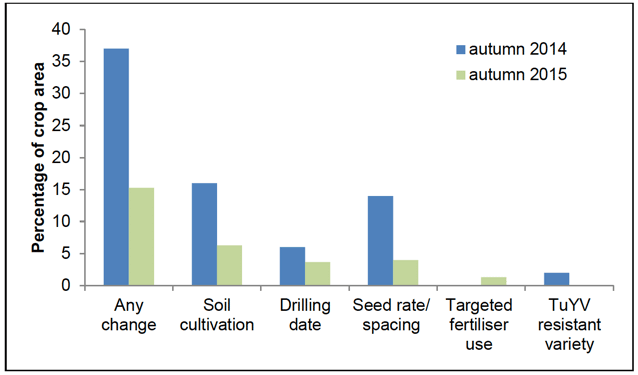
It should be noted that although the decrease in the proportion of growers adopting operational changes was sizable it was not statistically different between years (p=0.052).
The decision to make operational changes in the second year of the restrictions may have been influenced by the growers' prior experiences. In the first season, the impact of the lack of an insecticidal seed treatment was untested, and growers had no practical experience of whether changes to cultivation techniques were required. In contrast, in the second year of the restrictions their approach was informed by their experience in the preceding year. The 2014/15 survey indicated that, in Scotland, there were comparatively low levels of autumn crop loss to CSFB. The damage incurred may have been less than had been anticipated by Scottish growers and by the agricultural industry and press. With experience of a seed treatment free growing season, in which high levels of damage were infrequently encountered, Scottish growers may have considered that fewer interventions were necessary in autumn 2015. In addition, as noted earlier, sowing conditions in autumn 2015 were difficult, this additional pressure may also have influenced the decreased occurrence of adaptation of WOSR cultivations.
Grower perception of insect pest pressure
Growers were asked to rate their perception of aphid and flea beetle populations during crop emergence and establishment as low, moderate or high. As comparative ranking is subjective, growers were asked to report what methods they used to assess pest populations ( Table 4). It is important to note that, as in the previous survey, most respondents were growers, and their responses may not capture all actions performed by agronomists on their behalf.
Most growers (71 per cent) used more than one information source when assessing pest numbers. The majority (86 per cent) were advised by agronomists about pest presence in their crops. In addition, 60 per cent of growers reported that they conducted their own crop walking and inspection. Other sources of information used directly by growers included checking thresholds (28 per cent) and using traps (one grower). In addition, 35 per cent stated that they gained information about pest levels from technical bulletins produced by advisory bodies and also from the farming press. Many growers consulted more than one source of this type of general pest warning information. Twenty four and 21 per cent of growers used information from Scotland's Rural College ( SRUC) and the Agriculture and Horticulture Development Board ( AHDB), respectively and 10 per cent gained information from the farming media.
The adoption of a range of pest monitoring methods, and the reliance on use of agronomists and crop walking to inform growers about pest pressure reported here, is very similar to that encountered in the previous season (Figure 3). In 2014/15, 83 and 58 per cent of growers consulted agronomists and conducted crop walking, respectively. However, far fewer growers reported using thresholds (9 per cent) or consulting technical bulletins (7 per cent). The increased use of additional methods of pest monitoring at crop establishment encountered in the second year of the restrictions may, as discussed previously, indicate an increase in farmer experience and awareness of the importance of monitoring crops to determine the necessity and timing of sprays in the absence of a systemic seed treatment.
Figure 3 Pest assessment methods in 2014/15 and 2015/16 surveys
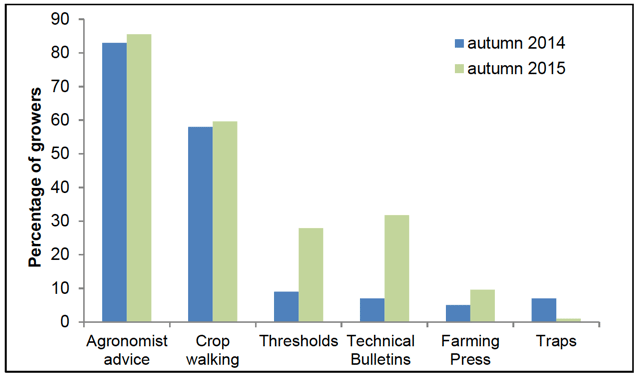
In relation to aphid pest pressure during crop establishment, the majority of growers reported that populations were either low (73 per cent) or that aphids were not seen on the crop (13 per cent) ( Table 5). A further six per cent reported aphid numbers to be moderate (low/moderate or moderate) and one per cent to be high. The remaining seven per cent did not monitor aphid populations.
Reported autumn aphid levels in this survey year were lower than in the previous year, in which 70 per cent of growers ranked aphids as low or not seen, 21 per cent as low/moderate or moderate and five per cent as moderate to high or high (Figure 4). The proportion of growers reporting aphid numbers as moderate or high in this survey was significantly lower than in the previous survey (p<0.001). No information about the species of aphid present was available in either survey year.
In relation to flea beetle presence, the majority of growers (82 per cent) also ranked populations as low or not seen (62 and 20 per cent respectively) ( Table 5). A further 13 per cent ranked levels as moderate (low/moderate or moderate) and two per cent as high (moderate/high or high). The remaining three per cent did not monitor flea beetle populations.
As with the aphid data, flea beetle populations were reported to be lower in autumn 2015 than autumn 2014 (Figure 5). In 2014, the majority of growers (62 per cent) reported flea beetle populations to be low or not seen (45 and 17 per cent respectively). A further 25 per cent ranked levels as moderate (low/moderate or moderate) and 10 per cent as high (moderate/high or high). The proportion of growers reporting flea beetle numbers as moderate or high in this survey was significantly lower than in the previous survey (p<0.001).
Figure 4 Aphid pest pressure in 2014/15 and 2015/16 surveys
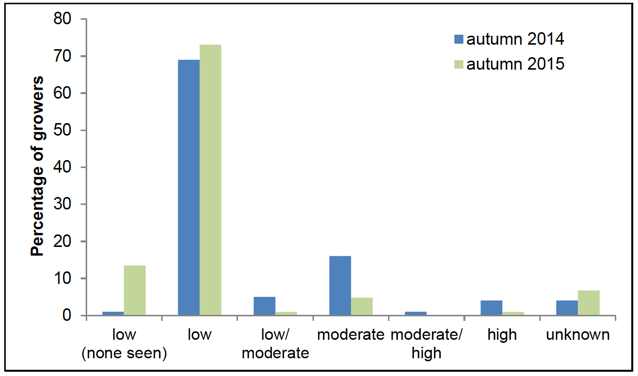
Figure 5 Flea beetle pest pressure in 2014/15 and 2015/16 surveys
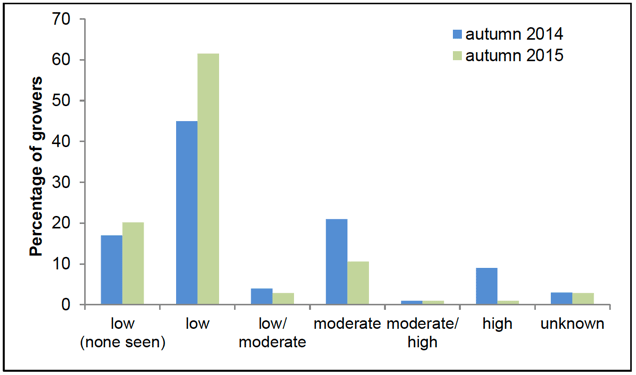
Of the 21 growers who reported flea beetles on their crops, the majority (62 per cent) identified them as CSFB. Five per cent stated that they were a combination of CSFB and Phyllotreta spp. flea beetles and five per cent as Phyllotreta spp. only. The remaining 29 per cent did not know which species of flea beetle were present ( Table 6).
This pattern is similar to that reported in the previous season, in which CSFB was also the species most commonly reported by growers who encountered flea beetles on their crops (51 per cent). A larger number of growers could not identify the species present in autumn 2014 (42 per cent) than in autumn 2015 (Figure 6). This may indicate increased grower knowledge of the pest species present, which could be associated with the increased use of thresholds and technical bulletins by growers in this survey. It may also be influenced by increased grower experience in pest identification in this second year of neonicotinoid restrictions.
Figure 6 Species of flea beetle in 2014/15 and 2015/16 surveys
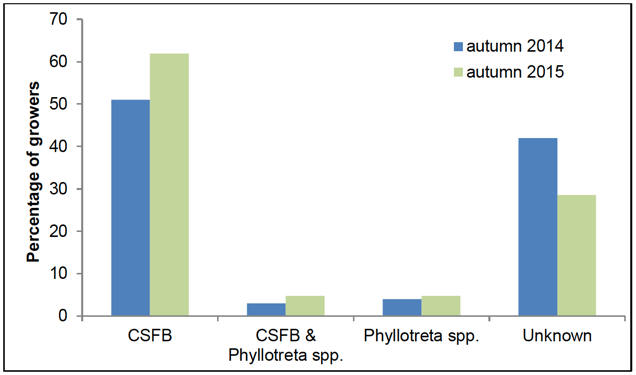
Autumn foliar insecticide use
Growers were asked to provide details of all insecticidal sprays applied during autumn 2015. In total, 56 sprays were applied by the 104 growers surveyed; an average of 0.54 sprays per grower.
More than half of the growers surveyed (56 per cent) did not use any insecticides in autumn 2015 ( Table 7). The majority of growers who did spray made a single application (36 per cent of the sample). This includes 31 per cent of growers applying a spray to their whole crop area and five per cent of growers who sprayed part of their crop area and left some fields untreated. Eight per cent of growers sprayed their crops with insecticides twice and one grower applied three sprays.
In relation to crop area, 3,090 ha of the crop was untreated, this represented 56 per cent of the survey area, and 2,463 ha received at least one spray. Of the treated crop area, 1,844 ha was treated once, 601 ha was treated twice and 18 ha received three sprays (33, 11 and <1 per cent of the sampled area respectively). The total treated area, including the repeat applications was 3,100 ha.
In the previous survey, growers had been asked about their pesticide use in both autumn 2013 and 2014; representing the year preceding, and the first year after, the introduction of the neonicotinoid restrictions (Figure 7). Fewer growers applied insecticides in this survey than in the previous year (44 and 61 percent respectively) and 24 per cent fewer sprays per grower were encountered (0.54 and 0.71 respectively). This reduction in the number of sprays per grower in 2015 was statistically significant (p<0.01).
Both the number of sprays per grower and the percentage of growers applying pesticides in autumn 2015 were similar to those reported in 2013 (0.48 and 47 per cent respectively), the year before the neonicotinoid restrictions were introduced. However, no pest population information is available for 2013; therefore it is not possible to directly compare pest control inputs.
Figure 7 Number of autumn insecticide sprays applied by growers in 2013, 2014 and 2015
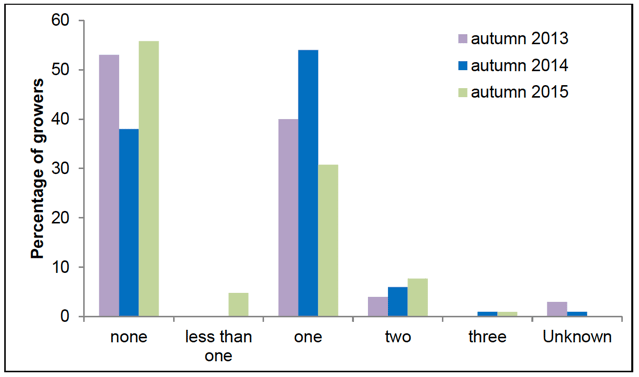
There were also reductions in the proportion of the crop area treated between autumn 2014 and 2015 (Figure 8). In 2014, 65 per cent of the crop received an autumn insecticide spray, compared to 44 per cent in 2015. This information is not available for 2013.
Figure 8 Autumn insecticide sprays by crop area in 2014/15 and 2015/16 surveys
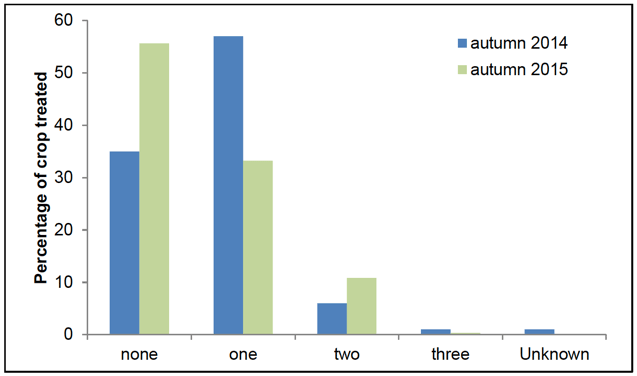
Insecticide application decision making process
Growers were asked what information they used when making the decision whether or not to apply a foliar insecticide to their crop ( Table 8). A range of responses were provided, with most farmers giving more than one reason. As this data was supplied by survey respondents, who were primarily growers, it may not capture all actions performed by agronomists on their behalf.
Most growers who applied an insecticide relied on an agronomist's advice when making the decision to spray (89 per cent). They were also informed by crop walking, use of thresholds and by reacting to information in technical bulletins (41, 20 and 4 per cent of those who sprayed, respectively). In addition to these reasons, nine growers (20 per cent of those who sprayed) stated that sprays were precautionary. Those growers that did not use an insecticide based this decision on agronomist advice (74 per cent), crop walking (40 per cent) and use of thresholds (16 per cent).
The reasons given for spraying in this survey were similar to those collected in autumn 2014 (Figure 9), with agronomist advice and crop walking being the most commonly encountered followed by use of thresholds and application of precautionary sprays.
Figure 9 Reasons for insecticide use in 2014/15 and 2015/16 surveys
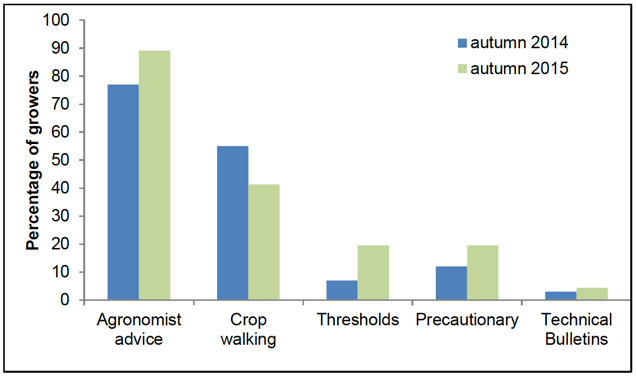
Targets of pesticide use
The pests targeted by the insecticide sprays applied by growers are presented in Table 9. Sprays were applied to combat aphids, flea beetles and rape winter stem weevil. However, the main focus of insecticide applications was flea beetle control, which accounted for 65 per cent of total sprays, and 71 per cent of the total treated area. Aphids were a target in 9 per cent of sprays (10 per cent of treated area). Rape winter stem weevil, which is not an approved target of neonicotinoid seed treatments, was the focus for 25 per cent of applications (19 per cent of treated area).
The targets encountered in autumn 2015 are very similar to those reported in the previous survey. In autumn 2014, flea beetles, aphids and rape winter stem weevil were the focus of 67, 4 and 22 per cent of sprays respectively and 73, 3 and 15 per cent of the total treated area.
Insecticide active substances applied
The insecticides encountered in this survey were almost exclusively pyrethroid compounds ( Table 10). The only exception was a single spray of the active substance pymetrozine, a pyridine insecticide. Four pyrethroid active substances were recorded; alpha cypermethrin, cypermethrin, lambda cyhalothrin, and zeta cypermethrin. Lambda cyhalothrin and zeta cypermethrin were the most frequently used compounds, together accounting for 84 per cent of sprays applied by growers and 80 per cent of the total area treated.
Pyrethroid insecticides were also the most commonly used compounds in the 2014/15 survey, accounting for all but one spray of acetamiprid (Figure 10). A greater range of pyrethroid active ingredients were encountered in autumn 2014, six in total, with the most commonly used being lambda cyhalothrin, zeta cypermethrin and cypermethrin, collectively accounting for 79 per cent of sprays applied by growers and 84 per cent of the total area treated.
Figure 10 Insecticide active substances applied in 2014/15 and 2015/16 surveys (percentage of total treated area)
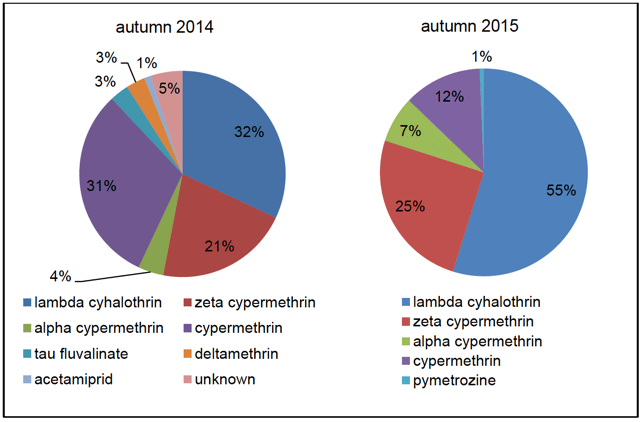
Reported efficacy of insecticidal sprays
Growers were asked whether they experienced problems controlling autumn insect pests ( Table 11). Despite concerns about the pyrethroid resistance status of both peach potato aphid and CSFB, the majority of the 46 growers who applied a spray did not report any problems with the efficacy of their pest control measures (87 per cent).
Of the six growers that did encounter problems controlling pests with pyrethroid insecticidal sprays, the majority (three growers) stated that high levels of CSFB made foliar control difficult. These growers did not consider this a pyrethroid resistance issue, but that large populations resulted in a continued problem with re-infestation which, in two cases, necessitated a second spray. One grower did state that they could not achieve sufficient efficacy with alpha-cypermethrin against CSFB, necessitating a second spray to control populations. In addition, two growers reported that weather conditions hampered spray application at the time it was needed.
Of the 58 growers that did not apply insecticides, six stated that they may have considered spraying but weather conditions precluded their use at the time at which they were needed.
Very similar responses were received from growers in the previous survey, in which 84 per cent of growers reported encountering no problems with spray efficacy. There was no statistical difference in response between the survey seasons (p>0.05).
Grower perception of autumn pest damage and crop loss
Growers were asked to rate autumn insect damage to their crops ( Table 12). They were also asked to indicate which species they thought were responsible for the damage incurred.
Insect damage, during the 2015 crop emergence and establishment period was rated as low by the majority of growers (67 per cent of growers and sample area). An additional 15 per cent of growers did not report any insect damage to their crops. Therefore, 82 per cent of growers, collectively growing 83 of the sampled crops, reported no or low insect damage in 2015. Fifteen percent of growers reported damage to be moderate (low/moderate or moderate) and one per cent reported high damage levels.
In autumn 2014, the proportion of growers reporting damage as moderate (28 per cent) or high (six per cent) was significantly greater than in this survey (p=0.001) (Figure 11). The reduced insect damage incurred in autumn 2015 reflects the reduced pest pressure encountered in this survey.
Figure 11 Autumn insect damage in 2014/15 and 2015/16 surveys
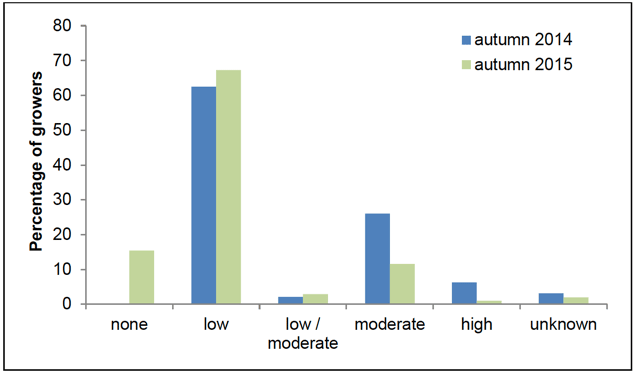
Growers were asked to identify the insect pests causing autumn damage to their crops ( Table 13). As would be expected, CSFB was the most commonly cited species (61 per cent of growers). Aphids are a vector of virus and symptoms are not apparent until later in the growing season (information about viral monitoring and incidence is presented in the post-harvest section of this report). This pattern is similar to the previous survey, in which the majority of autumn insect damage incurred was attributed to CSFB.
In addition to asking growers to rank damage, they were also asked whether they thought that the lack of seed treatment had resulted in greater autumn insect damage to their crops in 2015 than in the period before the restrictions were in place ( Table 14). Thirty eight per cent of growers responded yes, 54 per cent responded no and 8 per cent were not sure. These growers collectively cultivated 48, 47 and five per cent of sample area respectively. In 2014/15 the responses were 46 per cent yes, 49 per cent no and five per cent don't know.
Details of non-insect pest related damage to crops in autumn was also recorded ( Table 15). Almost all growers (94 per cent) reported experiencing other pest damage. The most frequent pests encountered were slugs, which were reported by 83 per cent of growers, followed by pigeons reported by 29 per cent. Rabbits, geese and deer were also reported to have damaged WOSR crops by a small number of growers.
For some growers, failure of the crop during emergence and establishment resulted in re-drilling of a proportion of the sample area ( Table 16). Of the 104 growers and 5,553 ha surveyed, seven growers collectively re-drilled 98 ha of failed crop (1.8 per cent of sample area). Of that area, 39 ha (0.7 per cent of the sample), grown by four farmers, were re-drilled due to damage from non-insect pests (slugs and geese). The remaining 59 ha (1.1 per cent of sample), grown by three farmers, was lost to poor weather at drilling and establishment. No crop loss was attributed to insect damage in 2015/16.
The overall level of crop loss encountered in this survey was very similar to the previous year in which 2.4 per cent of the sample was lost. There was no statistical difference in the number of growers who redrilled crops between the two years (p>0.05). In 2014/15, 1.1 per cent of the crop area was re-drilled due to CSFB damage and the remaining 1.3 percent was lost due to weather at drilling, poor seed vigour and damage from slugs, rabbits and pigeons.
Post-harvest data collection
All 104 growers were contacted post-harvest to collect data about TuYV incidence, yield and their attitude towards growing WOSR in the future. However, not all of the original participants responded at the second data collection point. Post-harvest data were collected from 98 growers, collectively growing 5,170ha of WOSR (17 per cent of the Scottish crop area).
Incidence of TuYV
Of the 98 growers who provided information, the majority (85 per cent) reported that their crops were visually checked for symptoms of TuYV and five per cent reported that viral symptoms were present. This is very similar to the pattern reported in the previous season when 79 per cent of growers checked their crops and four per cent reported the presence of symptoms.
In both years only one grower had crop samples tested for TuYV. In this survey the test was negative, in contrast to the previous survey where viral presence was confirmed. As discussed in the previous report, TuYV may be asymptomatic and can only be definitively diagnosed by serological testing. Therefore these data may underestimate viral presence. There were no significant differences in the proportion of growers checking for TuYV or for the observation of symptoms between the two surveys (p>0.05).
Crop yield
The average 2016 WOSR yield reported by the growers in this survey was 3.46 tonnes per hectare (t/ha), with a regional range of 3 to 3.85 t/ha ( Table 17). This is similar to the 2016 Scottish average yield of 3.31 t/ha reported by the Scottish Government (15) .
The majority of growers reported decreased yields in 2016 (84 per cent of growers, 87 percent of crop area). The remaining growers reported that yields were unchanged from the previous season (nine and eight per cent of growers and crop area respectively) or had increased (seven and five per cent of growers and area). Average yield declined in all geographic regions surveyed.
In the previous survey, yields of 4.21 and 4.28 t/ha were reported for 2014 and 2015 respectively (Figure 12). The 2016 survey yield is 19 per cent lower than that reported in 2015 and this decrease is statistically significant (p<0.001). There was also evidence of a significant interaction between yield and region (p=0.002), suggesting that the magnitude of yield change was not constant amongst regions.
Figure 12 Average WOSR yield of survey area in 2014, 2015 and 2016
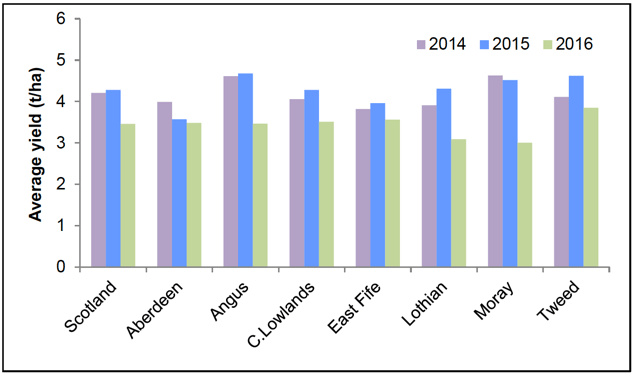
Scottish census data (15) also show a 20 per cent decrease in total Scottish oilseed rape yields in 2016 from the 20-year high yield of 4.15 t/ha in 2015 (Figure 13).
Figure 13 Average Scottish oilseed rape yield 1997-2016 (15)
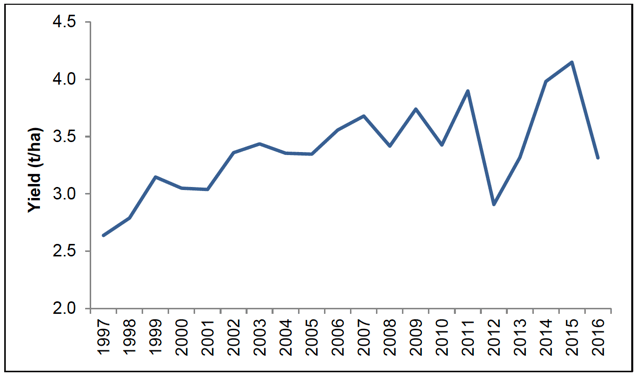
Whilst fluctuations of Scottish yield have been marked in recent years, it was reported that the large decrease in yield in 2016 was influenced by strong winds prior to harvest (15) . This was confirmed in our survey, in which the majority of growers who experienced a decrease in yield attributed this to the weather during the growing season (66 per cent stating weather alone and a further 14 per cent stating weather among other factors) ( Table 18). A range of contributing weather conditions were reported to have influenced yield decline; high winds prior to harvest causing seed shed (35 per cent of growers), a lack of sun in late spring/summer causing retardation of crop flowering, growth and impaired grain fill (28 per cent), wet conditions in autumn/winter hampering establishment (23 per cent) and crop growth retarded by the cold spring (six per cent). As well as poor weather conditions, yield was also reported to have been affected by other factors such as disease (clubroot), pigeon and slug damage as well as by weed growth, poor soil and late drilling in autumn 2015. Two growers, representing five per cent of those experiencing yield losses, reported that the CSFB damage had contributed to the decline. Both of these growers, who were located in the south of Scotland, also stated that lack of sun had also influenced yields.
Overall, the growers surveyed reported that a range of factors had contributed to the decline in yield, but that weather conditions, and in particular high winds pre-harvest, were the primary driver responsible for yield declines in comparison to the previous season.
Grower attitudes to future WOSR cultivation
Following harvest, growers were asked whether, based on their current experience, they would grow oilseed rape in future. The majority stated that they would continue to grow WOSR (75 per cent), 16 per cent stated that they would be less likely in future, six per cent more likely and three per cent didn't know. There was no significant difference in reported intentions of future WOSR cultivation between survey years (p>0.05, Figure 14).
Figure 14 Grower intention to cultivate WOSR in future in 2014/15 and 2015/16 surveys
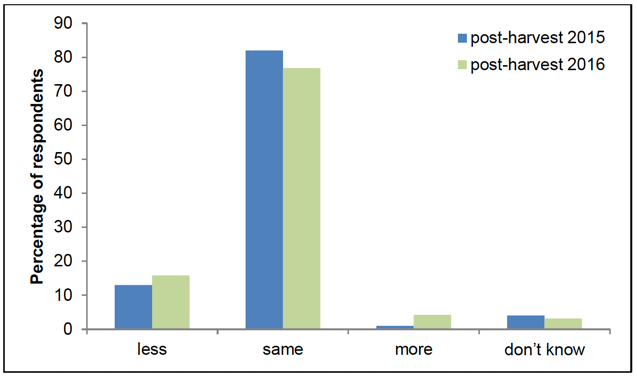
Growers were given the opportunity to comment on their response. Of the 15 growers who stated that they were less likely to grow WOSR in future, eight provided comments. Five stated that this decision was unrelated to the availability of seed treatments; but was influenced by general economic return, cultivation of alternative break crops and problems with slugs.
The other three growers were influenced by the neonicotinoid restrictions. These growers reported that the additional inputs and risk required to grow WOSR in the absence of insecticidal seed treatments made the crop less attractive.
In relation to those growers who specified that they would not change their WOSR cultivation, the majority stated that they had not encountered problems associated with the lack of an insecticidal seed treatment. However, some stated that they would reassess if this changed in future. Of the 6 growers who intended to sow more in 2017, all stated that this was due to not having encountered problems during the neonicotinoid restrictions, with one also citing increasing market price.
As with the previous survey, the common theme from growers was that the main drivers in choosing whether WOSR was grown in future were market price, input costs and economic return.
Contact
Email: Pesticide Survey unit
There is a problem
Thanks for your feedback